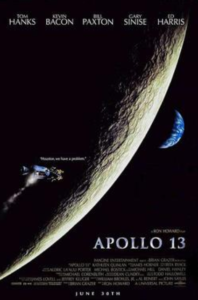Who doesn’t know the mission of the Star Trek voyages, narrated by William Shatner in the original series? The mission was stated at the first of every episode: “Space: the final frontier. These are the voyages of the starship Enterprise. Its five-year mission: to explore strange new worlds, to seek out new life and new civilizations, to boldly go where no man has gone before.” In 1989, NASA used the Star Trek version of the quotation to title its retrospective of Project Apollo: Where No Man Has Gone Before: A History of Apollo Lunar Exploration Missions.
One of my favorite movie scenes is from the 1995 film Apollo 13. In this clip, it is discovered there is a potentially fatal filter problem on the orbiting Apollo 13 rocket that must be corrected. The problem is, there are no replacement parts on board the rocket. In a moment that calls for pure innovation, the engineers back at ground control gather in a room to dive into fast-track experimentation in order to solve the problem. These rocket scientists are given these instructions:
“…We got (sic) to find a way to make this, fit into the hole for this, using nothing but that.”

The first “this” referred to in the above statement is a square box. The second “this” referred to is a round tube of the same size, creating the proverbial “square box in a round hole.” The “that” referred to in the above instructions is a bag containing only the materials available on board Apollo 13 to the astronauts. Those materials include a space suit and other random objects that are available to the astronauts trapped in space. There is nothing in the bag of “that” the engineers are given that would suggest a fix to the critical problem, yet under pressure and through the process of experimentation, an innovative solution is found.
In this short tableau based upon the true Apollo 13 story, all of the characteristics and elements of innovation are in evidence: the motivation of innovation comes through in the empathy expressed for those needing the solution; the spirit of empathy is given in the optimism that there will be an answer to fix the challenge; the methodology of innovation comes through in the experimentation that takes place as the various parts available to the engineers are integrated toward finding an emergent solution; tension is implied as the group ramps up for what they anticipate to be a challenging process ahead; the big idea is eventually found; and finally, the collaborative team turns the idea into reality (my POETIC acronym).
Malcolm Gladwell addresses this topic in his writing about creativity. In the essay The Gift of Doubt, Gladwell quotes Albert Hirschman and the power of failure, “We may be dealing here with a general principle of action,” Hirschman wrote:
Creativity always comes as a surprise to us; therefore we can never count on it and we dare not believe in it until it has happened. In other words, we would not consciously engage upon tasks whose success clearly requires that creativity be forthcoming. Hence, the only way in which we can bring our creative resources fully into play is by misjudging the nature of the task, by presenting it to ourselves as more routine, simple, undemanding of genuine creativity than it will turn out to be.
He continues:
People don’t seek out challenges. They are apt to take on and plunge into new tasks because of the erroneously presumed absence of a challenge—because the task looks easier and more manageable than it will turn out to be.
The entrepreneur takes risks but does not see themself as a risk-taker, because s/he operates under the useful delusion that what s/he’s attempting is not risky. Then, trapped in mid-mountain, people discover the truth—and, because it is too late to turn back, they’re forced to finish the job.
Experimentation is this middle ground on the road to innovation. Failures in the experimentation mean that that particular solution has to be ruled out. Optimism that there WILL be a solution keeps the journey alive.


Leave a Reply
You must be logged in to post a comment.